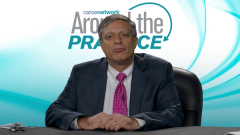
Non–BCMA-Targeting Bispecific Antibodies in R/R MM
A brief review of non–BCMA-targeted bispecific antibodies under investigation in patients with relapsed/refractory multiple myeloma.
Episodes in this series

Transcript:
Sandy Wong, MD: Let’s talk about GPRC5D. We already had talquetamab in study for quite some time. The package was just submitted to the FDA, so fingers crossed for that. [At the American Society for Hematology Annual Meeting] we heard about how Regeneron [Pharmaceuticals] also has a T-cell engager against the same target. If you look at the response rate, it looks comparable in terms of the adverse effects. One of the adverse effects we care most about—besides the nail and the skin changes, which seem very manageable—is dysgeusia, which stands out with talquetamab. You wonder how that is for the Regeneron drug. I was sitting in the front, and I was looking specifically for it but didn’t see it in the chart. Then I noticed that there was an asterisk on 1 of the mucosal disturbances. I was close enough to the slide to read the fine print on the bottom, and they lumped all that together under that category. It’s hard to tease out because they also lumped under that category dry mouth and other mucosal changes. I’d be curious to see the rate of dysgeusia with that drug. In terms of overall response rates, it looks similar. But it sounds like talquetamab is much further along in terms of development.
Samuel M. Rubinstein, MD: That seems likely to be a class effect, right? The CARs [chimeric antigen receptors] that target GPRC5D result in a similar toxicity profile. There’s probably something about that target.
Sandy Wong, MD: Absolutely.
Samuel M. Rubinstein, MD: It’s definitely better with CAR.
Sandy Wong, MD: It’s better with CAR. Maybe we can talk about that when the CAR section comes up. It’s exciting that we’ll have options in that group. Last but not least is cevostamab. That is the T-cell engager that’s erected against FCRH5. I applaud them for doing this. There were a couple of presentations. One was using tocilizumab prophylactically to see how it changes CRS [cytokine release syndrome]. I was floored by this. We’ve all been concerned about needing to admit these patients into the hospital to start them on T-cell engagers. That’s a big strain on our resources. We need to figure out a way to be able to do this as an outpatient [basis] and in the community [setting]. That was exciting to see, that if you give tocilizumab prophylactically, it looks like the CRS rates drop by half. That’s wonderful. It didn’t seem to affect the efficacy in terms of overall response rate.
Timothy Schmidt, MD: It looked a little better.
Sandy Wong, MD: Yes.
Samuel M. Rubinstein, MD: It looked a little better. It’s very exciting about potentially deferring the heavy resource utilization of inpatient initiation of bispecifics with that type of strategy. How do you juxtapose that with the resource pushed on tocilizumab, which exists in finite quantity? That’s hard.
Transcript edited for clarity.
Newsletter
Stay up to date on recent advances in the multidisciplinary approach to cancer.



































































































